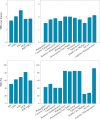High occurrence of transportation and logistics occupations among vascular dementia patients: an observational study
- PMID: 31882022
- PMCID: PMC6933928
- DOI: 10.1186/s13195-019-0570-4
High occurrence of transportation and logistics occupations among vascular dementia patients: an observational study
Abstract
Background: Growing evidence suggests a role of occupation in the emergence and manifestation of dementia. Occupations are often defined by complexity level, although working environments and activities differ in several other important ways. We aimed to capture the multi-faceted nature of occupation through its measurement as a qualitative (instead of a quantitative) variable and explored its relationship with different types of dementia.
Methods: We collected occupational information of 2121 dementia patients with various suspected etiologies from the Amsterdam Dementia Cohort (age 67 ± 8, 57% male; MMSE 21 ± 5). Our final sample included individuals with Alzheimer's disease (AD) dementia (n = 1467), frontotemporal dementia (n = 281), vascular dementia (n = 98), Lewy body disease (n = 174), and progressive supranuclear palsy/corticobasal degeneration (n = 101). Within the AD group, we used neuropsychological data to further characterize patients by clinical phenotypes. All participants were categorized into 1 of 11 occupational classes, across which we evaluated the distribution of dementia (sub)types with χ2 analyses. We gained further insight into occupation-dementia relationships through post hoc logistic regressions that included various demographic and health characteristics as explanatory variables.
Results: There were significant differences in the distribution of dementia types across occupation groups (χ2 = 85.87, p < .001). Vascular dementia was relatively common in the Transportation/Logistics sector, and higher vascular risk factors partly explained this relationship. AD occurred less in Transportation/Logistics and more in Health Care/Welfare occupations, which related to a higher/lower percentage of males. We found no relationships between occupational classes and clinical phenotypes of AD (χ2 = 53.65, n.s.).
Conclusions: Relationships between occupation and dementia seem to exist beyond the complexity level, which offers new opportunities for disease prevention and improvement of occupational health policy.
Keywords: Alzheimer’s disease; Occupation; Sex; Vascular dementia; Vascular risk factors.
Conflict of interest statement
The authors declare that they have no competing interests.
Figures



Similar articles
-
Occupation during life and risk of dementia in French elderly community residents.J Neurol Neurosurg Psychiatry. 2001 Sep;71(3):303-9. doi: 10.1136/jnnp.71.3.303. J Neurol Neurosurg Psychiatry. 2001. PMID: 11511701 Free PMC article.
-
The clinical diagnosis of early-onset dementias: diagnostic accuracy and clinicopathological relationships.Brain. 2011 Sep;134(Pt 9):2478-92. doi: 10.1093/brain/awr189. Epub 2011 Aug 11. Brain. 2011. PMID: 21840888
-
Education, occupation, and prevalence of dementia: findings from the Conselice study.Dement Geriatr Cogn Disord. 2002;14(2):90-100. doi: 10.1159/000064930. Dement Geriatr Cogn Disord. 2002. PMID: 12145456
-
Diagnosis and management of vascular cognitive impairment and dementia.J Neural Transm Suppl. 2002;(63):91-109. doi: 10.1007/978-3-7091-6137-1_6. J Neural Transm Suppl. 2002. PMID: 12597611 Review.
-
Cognitive-behavioral profiles of neurodegenerative dementias: beyond Alzheimer's disease.J Geriatr Psychiatry Neurol. 2007 Dec;20(4):227-38. doi: 10.1177/0891988707308806. J Geriatr Psychiatry Neurol. 2007. PMID: 18004009 Review.
Cited by
-
Rationale and design of the BeyeOMARKER study: prospective evaluation of blood- and eye-based biomarkers for early detection of Alzheimer's disease pathology in the eye clinic.Alzheimers Res Ther. 2024 Aug 21;16(1):190. doi: 10.1186/s13195-024-01545-1. Alzheimers Res Ther. 2024. PMID: 39169442 Free PMC article.
-
2024 Heart Disease and Stroke Statistics: A Report of US and Global Data From the American Heart Association.Circulation. 2024 Feb 20;149(8):e347-e913. doi: 10.1161/CIR.0000000000001209. Epub 2024 Jan 24. Circulation. 2024. PMID: 38264914 Free PMC article. Review.
-
Association of perturbation of oral bacterial with incident of Alzheimer's disease: A pilot study.J Clin Lab Anal. 2022 Jul;36(7):e24483. doi: 10.1002/jcla.24483. Epub 2022 Jun 11. J Clin Lab Anal. 2022. PMID: 35689551 Free PMC article.
-
Occupational and domestic exposure associations with cerebral small vessel disease and vascular dementia: A systematic review and meta-analysis.Alzheimers Dement. 2024 Apr;20(4):3021-3033. doi: 10.1002/alz.13647. Epub 2024 Jan 25. Alzheimers Dement. 2024. PMID: 38270898 Free PMC article.
-
Heart Disease and Stroke Statistics-2023 Update: A Report From the American Heart Association.Circulation. 2023 Feb 21;147(8):e93-e621. doi: 10.1161/CIR.0000000000001123. Epub 2023 Jan 25. Circulation. 2023. PMID: 36695182 Free PMC article. Review.
References
-
- Prince M, Wilmo A, Guerchet M, Ali G, Wu Y, Prina M. World Alzheimer Report 2015. The global impact of dementia: an analysis of prevalence, incidence, cost and trends. Alzheimer’s Dis Int. 2015. https://www.alz.co.uk/research/WorldAlzheimerReport2015.pdf.
Publication types
MeSH terms
LinkOut - more resources
Full Text Sources
Miscellaneous

